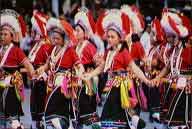Chinese Dancing
The
art of Chinese
dance traces its origins to even before the appearance of the first written
Chinese characters. Ceramic pots have been unearthed in the Sun Chia Chai
excavation site in Tatung County of the western Chinese province of Chinghai
that depict colorful dancing figures. A study of these archaeological artifacts
reveals that people of the Neolithic Yangshao culture of around the fourth
millennium B.C. already had choreo graphed group dances in which the participants
locked arms and stamped their feet while singing to instrumental accompaniment.
Chinese dance
was divided into two types, civilian and military, during the Shang and Chou
periods of the first millennium B.C. In civilian dance, dancers held feather
banners in their hands, symbolizing the distribution of the fruits of the
day's hunting or fishing. This gradually developed into the dance used in
the emperor's periodic sacrificial rituals held outside the city, and other
religious rituals.
Each minority people or aboriginal group of China has its own folk dance forms. The Miao (also known as Hmong) people of southwestern China, for example, developed a lively form of antiphonal singing and competitive dance; the aborigines of Taiwan, influenced by their island life and environment, created hand-holding line dances as part of a harvest ritual. Folk dances directly reflect the lifestyles and customs of a people, and in addition to their artistic value as dances, they are a precious part of China's cultural heritage.
In the Republic of China on Taiwan, the development of Chinese
dance has taken on a dynamic and multifaceted personality. Young people
going into dance usually first study ballet and modern dance, then go back
to take a fresh look at the syntax of traditional Chinese dance. From there
they seek out new directions for Chinese style body expression with an open
mind and spirit of experimentation. Since about 1970, their original and unique
compositions have occasioned a renaissance in Chinese
dance.
Diversified Chinese Dances
Chinese
Folk Dance
XingJiang Drum Dance, Taiwanese Folk Dance, Taiwan Aborginal Dance,
Kung-Fu Fan Dance, Yunan Dai folk dance, Dunhuang Aesthetic Dance.
Traditional Chinese Dance
Dragon Dance, Feather Fan Dance, Traditional Chinese Ribbon Dance,
Ribbon Dance, Silk Fan Dance, Sword Dance.
Chinese Modern Dance
Chinese modern dance is a unification of Live Music and Dance.
Calligraphy Dance combined the art of dance and Chinese calligraphy presentation.
Festivals
Chinese New Year
Ching Ming
Tin Hau
Tuen Ng (Dragon Boat) Festival
Cheng Chau Festival
Birthday of Buddha
Compiled
by: Glenn Welker
Copyright © 1993-2009
This page last updated 03/18/2009 13:06:25
